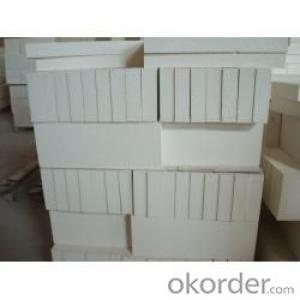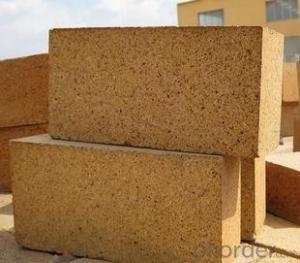Insulating Fire Brick Bubble Low Alumina Bricks
- Loading Port:
- China Main Port
- Payment Terms:
- TT OR LC
- Min Order Qty:
- -
- Supply Capability:
- -
OKorder Service Pledge
Quality Product, Order Online Tracking, Timely Delivery
OKorder Financial Service
Credit Rating, Credit Services, Credit Purchasing
You Might Also Like
Specifications
Alumina bubble brick
1)95% alumina
2)acid and alkali resistant
3)SGS,ISO
4)Rich size
Alumina Ceramic Liner AL2O3 99.5%
Parameter
| AL2O3 | ≥90% |
| SiO2 | ≤7% |
| CaO+MgO+Fe2O3+others | 2% |
| True Density | 3.60g/cm3 |
| Water Absorption | <0.01% |
| Hardness(Mohs) | ≥9 |
| Color | White |
We supply high quality Bubble Alumina Bricks to clients.
Quick Details:
| Place of Origin: China (Mainland) | Shape: Brick | Material: Alumina Cement |
| SiO2 Content (%): 0 | Al2O3 Content (%): 92 | MgO Content (%): 0 |
| CaO Content (%): 0 | Refractoriness (Degree): Common (1580°< Refract... | CrO Content (%): 0 |
| SiC Content (%): 0 | Model Number: ADAB | Brand Name: CNBM |
| Function: Acid Resistance Bricks | Color: White | Porosity: Solid |
| Type: acid resistant ceramic brick |
- Q: Can insulating fire bricks be used in thermal oxidizers?
- Insulating fire bricks are indeed applicable for thermal oxidizers. These bricks are specifically designed to possess low thermal conductivity, enabling them to effectively diminish heat transfer and conserve energy in high-temperature scenarios. Thermal oxidizers, on the other hand, are utilized as devices for treating industrial exhaust gases through the process of oxidizing pollutants at elevated temperatures. By incorporating insulating fire bricks into the construction of thermal oxidizers, the system can confine heat within, ensuring efficient combustion while minimizing heat loss to the surrounding environment. Consequently, this not only enhances the overall thermal efficiency of the thermal oxidizer but also aids in decreasing energy consumption and operational expenses. Furthermore, insulating fire bricks possess remarkable resistance against thermal shock and display exceptional insulating properties, rendering them suitable for the challenging and rigorous conditions commonly encountered in thermal oxidizers.
- Q: Can insulating fire bricks be used in chimney lining?
- Indeed, insulating fire bricks are a suitable option for chimney lining. These bricks are specifically engineered to endure extreme heat and offer exceptional insulation. Their ability to retain heat within the chimney prevents any loss through the walls, which ultimately enhances the efficiency of fireplaces or stoves. Moreover, their lightweight nature and straightforward installation process have contributed to their popularity in chimney lining projects. Nonetheless, it is crucial to verify that the chosen insulating fire brick meets the requirements for chimney applications and adheres to local building codes and regulations.
- Q: Can insulating fire bricks be used in the construction of thermal insulation floors?
- Yes, insulating fire bricks can be used in the construction of thermal insulation floors. These bricks are designed to provide excellent thermal insulation properties, making them suitable for use in floor applications where insulation is required.
- Q: Can insulating fire bricks be used to line industrial boilers?
- Industrial boilers can be lined with insulating fire bricks, which have low thermal conductivity and can minimize heat loss and enhance energy efficiency. These bricks, made of lightweight materials like clay and alumina, possess excellent insulation properties. By lining the boiler's interior with these bricks, the heat generated during combustion can be contained, resulting in greater heating efficiency and decreased fuel consumption. Moreover, these bricks are capable of withstanding high temperatures and thermal shocks, making them ideal for the challenging conditions commonly found in industrial boilers. Overall, utilizing insulating fire bricks as lining material can lead to improved energy efficiency, reduced operating expenses, and enhanced durability of the boiler system.
- Q: Can insulating fire bricks be used in the construction of brick kilns?
- Insulating fire bricks are capable of being utilized in the construction of brick kilns. Designed specifically with high thermal resistance, these bricks are well-suited for scenarios requiring insulation. Within brick kilns, insulating fire bricks may be employed to line the walls, floor, and roof of the kiln, effectively maintaining heat and enhancing energy efficiency. These bricks possess the ability to withstand elevated temperatures, providing insulation against the heat generated throughout the firing process. Furthermore, they aid in reducing heat loss, resulting in quicker and more efficient firing cycles. In conclusion, incorporating insulating fire bricks into the construction of brick kilns can elevate their performance and contribute to a more effective and sustainable operation.
- Q: Are insulating fire bricks easy to handle and install?
- Insulating fire bricks are known for their ease of handling and installation. They possess a lightweight composition, enabling effortless transportation and portability. Furthermore, their user-friendly design, in terms of shape and size, facilitates simple manipulation and installation. The majority of insulating fire bricks are equipped with pre-drilled holes or grooves, further streamlining the installation process. Moreover, these bricks offer high versatility as they can be easily cut or shaped to accommodate specific dimensions or requirements. As a result, even individuals with limited expertise or familiarity in masonry work find insulating fire bricks to be manageable and straightforward to handle and install.
- Q: Are insulating fire bricks resistant to thermal bridging?
- Yes, insulating fire bricks are resistant to thermal bridging. Thermal bridging occurs when there is a direct path for heat to flow through a material, bypassing the insulation. Insulating fire bricks are designed to minimize this by having low thermal conductivity, which means they are not effective at conducting heat. This helps to maintain a consistent temperature on both sides of the brick, preventing thermal bridging and improving the overall insulation performance.
- Q: Do insulating fire bricks have a high fire resistance rating?
- Yes, insulating fire bricks have a high fire resistance rating. Insulating fire bricks are specially designed to withstand high temperatures and provide excellent insulation against heat transfer. They are made from high-purity refractory materials, such as alumina and silica, which have a high melting point and can withstand extreme heat. These bricks are capable of withstanding temperatures of up to 3000°F (1650°C) and have a thermal conductivity that is much lower than regular bricks or other materials. This makes them ideal for use in applications where high fire resistance is required, such as in industrial furnaces, kilns, fireplaces, and chimneys. Additionally, their insulating properties help to reduce heat loss, making them energy-efficient and cost-effective.
- Q: Do insulating fire bricks have a low density?
- Insulating fire bricks possess a lower density in comparison to alternative brick types. Such bricks are engineered to embody a porous structure, thereby facilitating heat transfer reduction and insulation enhancement. The lightweight characteristic of these insulating fire bricks enables them to furnish efficient thermal insulation. Consequently, they prove apt for a multitude of applications wherein heat preservation and energy efficiency hold paramount significance, such as kilns, furnaces, and fireplaces.
- Q: Are insulating fire bricks resistant to ammonia gas?
- Insulating fire bricks are generally not resistant to ammonia gas. While these bricks are designed to withstand high temperatures and provide thermal insulation, they are typically made from lightweight refractory materials such as clay or silica, which are not highly resistant to corrosive substances like ammonia gas. Ammonia gas can react with these materials and cause degradation or damage to the bricks over time. Therefore, if you need to use fire bricks in an environment with ammonia gas, it is recommended to choose specially designed acid-resistant or chemical-resistant bricks that can withstand the corrosive effects of ammonia gas.
Send your message to us
Insulating Fire Brick Bubble Low Alumina Bricks
- Loading Port:
- China Main Port
- Payment Terms:
- TT OR LC
- Min Order Qty:
- -
- Supply Capability:
- -
OKorder Service Pledge
Quality Product, Order Online Tracking, Timely Delivery
OKorder Financial Service
Credit Rating, Credit Services, Credit Purchasing
Similar products
Hot products
Hot Searches
Related keywords
























